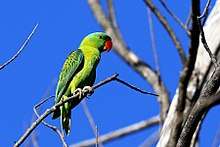Blue-naped parrot
The blue-naped parrot (Tanygnathus lucionensis), also known as the blue-crowned green parrot, Luzon parrot, the Philippine green parrot, and locally known as pikoy, is a parrot found throughout the Philippines.
| Blue-naped parrot | |
|---|---|
 | |
| Scientific classification | |
| Kingdom: | Animalia |
| Phylum: | Chordata |
| Class: | Aves |
| Order: | Psittaciformes |
| Family: | Psittaculidae |
| Genus: | Tanygnathus |
| Species: | T. lucionensis |
| Binomial name | |
| Tanygnathus lucionensis (Linnaeus, 1766) | |
| Synonyms | |
|
Psittacus lucionensis Linnaeus, 1766 | |
Taxonomy
In 1760 the French zoologist Mathurin Jacques Brisson included a description of the blue-naped parrot in his Ornithologie based on a specimen collected on the island of Luzon in the Philippines. He used the French name Le perroquet de l'Isle de Luçon and the Latin name Psittacus lucionensis.[2] Although Brisson coined Latin names, these do not conform to the binomial system and are not recognised by the International Commission on Zoological Nomenclature.[3] When in 1766 the Swedish naturalist Carl Linnaeus updated his Systema Naturae for the twelfth edition he added 240 species that had been previously described by Brisson.[3] One of these was the blue-naped parrot. Linnaeus included a terse description, used the binomial name Psittacus lucionensis and cited Brisson's work.[4] The specific name lucionensis is from Luzon in the Philippines.[5] This species is now placed in the genus Tanygnathus which was introduced by the German naturalist Johann Wagler in 1832.[6]
There are four subspecies:[7]
- T. l. lucionensis: Luzon and Mindoro
- T. l. hybridus: Polillo Islands. Blue on crown less extensive, tinged with violet. More green on wing coverts.
- T. l. salvadorii: Rest of Philippines
- T. l. talautensis: Talaud
Description
This is a medium size parrot, around 31 cm (12 in) in length, primarily green except for a light blue rear crown and nape, pale blue lower back and rump, scalloped shoulders with orange-brown on black coverts, and blackish underwings with green underwing coverts.[8]
Distribution and ecology
The species is widespread throughout the Philippines, including the Talaud Islands and islands off north and east Borneo (with introduced population in Borneo itself, e.g. Kota Kinabalu). It is found in secondary forest, at forest edges and in plantations at elevations of up to 1000 m. Flock size is usually under a dozen. The blue-naped parrot feeds on mangoes, berries, seeds, nuts and grains. It nests in tree holes.[1]
Conservation
Habitat loss and trapping have has made this species scarce on most islands except Mindoro and Palawan.[1] The Katala Foundation has raised concerns over the increasing illegal trade of this bird on Palawan.[9]
Gallery
 In Luzon, the Philippines
In Luzon, the Philippines At Walsrode Bird Park
At Walsrode Bird Park Three hand-reared chicks
Three hand-reared chicks
References
- BirdLife International (2012). "Tanygnathus lucionensis". IUCN Red List of Threatened Species. 2012. Retrieved 26 November 2013.CS1 maint: ref=harv (link)
- Brisson, Mathurin Jacques (1760). Ornithologie, ou, Méthode contenant la division des oiseaux en ordres, sections, genres, especes & leurs variétés (in French and Latin). Volume 4. Paris: Jean-Baptiste Bauche. pp. 295–297, Plate 22 fig 2. The two stars (**) at the start of the section indicates that Brisson based his description on the examination of a specimen.
- Allen, J.A. (1910). "Collation of Brisson's genera of birds with those of Linnaeus". Bulletin of the American Museum of Natural History. 28: 317–335.
- Linnaeus, Carl (1766). Systema naturae : per regna tria natura, secundum classes, ordines, genera, species, cum characteribus, differentiis, synonymis, locis (in Latin). Volume 1, Part 1 (12th ed.). Holmiae (Stockholm): Laurentii Salvii. p. 146.
- Jobling, J.A. (2018). del Hoyo, J.; Elliott, A.; Sargatal, J.; Christie, D.A.; de Juana, E. (eds.). "Key to Scientific Names in Ornithology". Handbook of the Birds of the World Alive. Lynx Edicions. Retrieved 2 April 2018.
- Wagler, Johann Georg (1832). "Monographia Psittacorum". Abhandlungen der mathematisch-physikalischen Classe, Königlich-Bayerische Akademie der Wissenschaften (in Latin). 1: 463-750 [501].
- Gill, Frank; Donsker, David, eds. (2018). "Parrots, cockatoos". World Bird List Version 8.1. International Ornithologists' Union. Retrieved 4 April 2018.
- Juniper, T.; Parr, M. (1998). Parrots: A Guide to Parrots of the World. New Haven and London: Yale University Press. ISBN 0-300-07453-0.
- "Palawan's wildlife faces extinction risk due to mining, pet trade". Mongabay. 17 September 2008.
Further reading
- Dickinson, E.C.; Kennedy, R.S.; Parkes, K.C. (1991). The birds of the Philippines: An annotated check-list. British Ornithologists' Union Check-list. No. 12.
- Kennedy, R.S.; Gonzales, P.C.; Dickinson, E.C.; Miranda Jr., H.C.; Fisher, T.H. (2000). A Guide to the Birds of the Philippines. Oxford and New York: Oxford University Press. ISBN 0-19-854668-8.
External links
- Oriental Bird Images: Blue-naped parrot Selected photos
